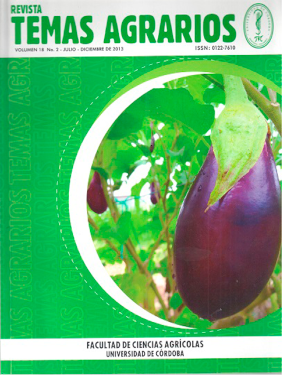Determination of compositional and thermal properties of flour and starch of chachafruto (Erytina Edulis Triana Ex Micheli)
Determinación de las propiedades térmicas y composicionales de la harina y almidón de chachafruto (erytina edulis triana ex micheli)

This work is licensed under a Creative Commons Attribution-NonCommercial 4.0 International License.
Show authors biography
This paper presents a study on the chemical, thermal and structural properties of chachafruto´s flours and starches. A proximal analysis was performed both flour and starch of chachafruto (Erytrina Edulis Triana Ex Micheli) determining parameters such as moisture, minerals, protein, fat, fiber and starch percentage. The thermal properties were determined with the techniques of differential scanning calorimetry, thermogravimetric analysis and Rapid Viscoamilography Analysis and structural were determined by X-ray diffraction and scanning electronic microscopy. The proximal analysis for flour presented: moisture 12.33%, ash 1.55%, 18.5% protein, ether extract 2.50%. For starch: Moisture 12.60%, 0.90% ash, ether extract 1.82% and 0.8% protein. Starch granules spherical and ovoid forms submitted. The TGA for flour showed a temperature of moisture loss of 119.99°C, the maximum temperature of decomposition was presented in the 272.5°C and finally the process ends at 581°C. Starch granules presented spherical and ovoid forms. To the flour, the temperature of moisture loss was 119.99°C, the maximum temperature of decomposition was presented in the 272.5°C and finally the process ends at 581°C. For starch, the decomposition of water was established at 200.94°C, the maximum temperature of decomposition showed a peak at 300°C and the process ended at 584.72°C. When performing the DSC analysis for the flour was found that the characteristic temperatures for the gelatinization process are TO= 62.06°C, TP= 70, 98°C, TF=78.62°C and for starch was obtained that TO= 56.65°C, TP= 70.06%, TF= 85.12°C
Article visits 2043 | PDF visits
Downloads
- AACC International. 2000. Approved Methods of American Association of Cereal Chemists, 10th Ed. Method 08-01, Method 30-25 and Method 46-13. The Association: St. Paul, MN.
- AOAC. 2000. Official Methods of Analysis of the Association of Official Analytical Chemists 17th Ed. Method 925.10, 920.86, 992.16 and 965.17. The Association: Gaithersburg, MD. USA
- Biliaderis, C. 1992. Structures and Phase Transitions of Starch in Food Systems. Food Technology,145.
- Coral, D. 2007. Caracterización térmica de biopolímeros derivados del maíz: almidón. Universidad Nacional de Colombia.
- Delpeuch, F. y Favier, J. 1980. Caracteristique des amidons de plantas alimentaires tropicales: action de l´alpha-amylase, gonflement et solubilité. Paris, Ann. Technol. Agric., 29(1): 53-67.
- Dufour, D., Gibert, O., Giraldo, A., Sanchez, T., Reynes, M., Pain, J., Gonzalez, A., Fernandez, A. and DÌaz, A. (2009). Differentiation between cooking bananas and dessert Bananas. 2. Thermal and functional characterization of cultivated colombian Musaceae (Musa sp.). Journal of Agriculture and Food Chemistry. 209-216.
- Dufour, D., Gibert, O., Giraldo, A., Sanchez, T, Reynes, M., Pain, J. P., Gonzalez, A., Fernandez, A. and Diaz, A. 2009. Differentiation between cooking bananas and dessert Bananas. 2. Thermal and functional characterization of cultivated colombian Musaceae (Musa sp.). Journal of Agriculture and Food Chemistry. 53-68.
- Hermansson, A. and Svegmark K. 1996. Developments in the understanding of starch functionality. Trends in Food Science & Technology, Vol. 71. 29-38
- Jamroz, J and Sujka M. 2009. ɲ-Amylolysis of native potato and corn starches – SEM, AFM, nitrogen and iodine sorption investigations.» LWT - Food Science and Technology, 1219 - 1224.
- Jianhua L., Bin W. and Jianyou Z. 2011. Functional, physicochemical properties and structure of cross-linked oxidized maize starch. Food Hydrocolloids, 413- 425.
- Lucas, J. and Quintero, V. 2013. Caracterización de harina y almidón obtenidos a partir de plátano guineo AAAea (Musa sapientum L.).» ACTA Agronómica: 83 - 96.
- Latham, M. 2002. Nutrición humana en el mundo en desarrollo. Organización de las Naciones Unidas para la Agricultura y la Alimentación. Colección FAO: Alimentación y nutrición N° 29. Roma.
- Lucas, A., Dufour, D. y Díaz, A. 2010. Caracterización físico – química y evaluación de las curvas de empastamiento de tres variedades de plátano: Hartón (Musa AAB), Cubano blanco (Musa AAB), Cachaco (Musa ABB). ACORBAT, Medellín - Colombia.
- Nimsung, P., Thongngam, M and Naivikul, O. 2007. Compositions, morphological and thermal properties of green banana flour and starch. Kasetsart , 127-134.
- Pacheco, E. y Techeira, N. 2009. Propiedades químicas y funcionales del almidón nativo y modificado de ñame. Interciencia, 38-50.
- Pineda, P., Coral, D and Ramos, D. 2011. Thermo-alkaline treatment. A process that changes the thermal properties of corn starch.» Procedia Food Science, 370-378.
- Rojas, I., Gutiérrez, E., Palacios, A., Baños, L., Pons, J., Guzmán, S., Pineda, P. and Rodríguez, M. 2007. Study of structural and thermal changes in endosperm of quality protein maize during traditional nixtamalization process. Cereal Chem. 84 (4), 304–312.
- Ruskin, F. 1989. Basul. In Lost crops of the Incas. Washington, DC: National Academy Press, pp. 164–71.
- Londoño, S., Rincón, N., Contreras, M., Acosta, A., Bello, L., Lucas, J., Dumar, V., Pineda, P., Del Real. A. and Rodriguez, M. 2014. Physicochemical, morpholoical, and rheological characterization of Xanthosoma robustum Lego-like starch. International Journal of Biological Macromolecules,: 222-228.
- Jyothirmayi, T. y Prabhakara P. 2006. Nitrogen extractability and functional properties. Food Chemistry: 242–247.
- Vega, D., Villar, M., Failla, M. and Valles, E. 1996. Polymer Bulletin 37, 229-235.
- Yaoqi T., Yin L., Xueming X. and Zhengyu J. 2011. Starch retrogradation studied by thermogravimetric analysis (TGA).» Carbohydrate Polymers, 1165–1168.
- Young, V. and Pellet, P. 1994. Plant proteins in relation to human protein and amino acid nutrition. Am. J. Clin. Nutr., 59 (Suppl.): 1203S-1212S.
- Zaidul, I., Norulaini, N., Mohd. O., Yamauchi, H. y Noda, T. 2007. RVA analysis of mixtures of wheat flour and potato, sweet potato, yam, and cassava starches. Carbohydrate Polymers 69: 784–791.




















